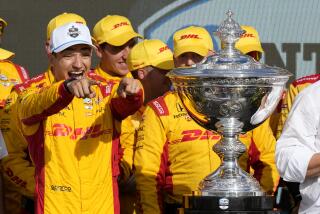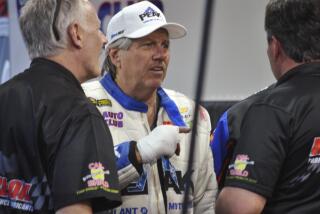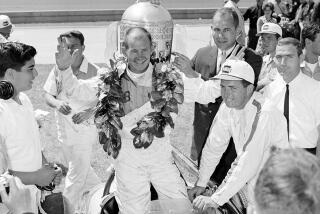Sharp’s Crash a Sign of Things to Come?
INDIANAPOLIS — Concerns that scant supplies of engines, practice time and reliable equipment might diminish the Indy Racing League’s efforts to change the face of the Indianapolis 500 were intensified Friday when Scott Sharp’s two-day-old G Force-Aurora slammed into the wall in a 214-mph crash.
Sharp, who carries the IRL’s No. 1 designation on the sides of his A.J. Foyt-owned car, was taken to Methodist Hospital where Dr. Henry Bock said Sharp had suffered a concussion.
The accident, on the eve of today’s pole time trials for the May 25 race, was Scott’s second in three days and raised fears that continued engine failures could mar qualifying and the race.
Sharp, one of the brightest young American drivers and hand-picked by Foyt to carry his colors in the IRL, had said Wednesday’s crash happened because the Olds Aurora V-8 engine in his car seized as he raced through the fourth turn of the 2 1/2-mile rectangular oval.
“The engine just locked up, just when it was running so smoothly,” Sharp said after Wednesday’s crash. “I could feel it tighten up. It just snapped the car around. I was fortunate it turned in early, so I didn’t hit as hard as it might.”
In the earlier accident, Sharp, co-champion with Buzz Calkins of the inaugural IRL season, suffered only a bruised knee, although the car was badly damaged.
Friday’s hit was almost a carbon copy, occurring at the same spot in the fourth turn, except that this time the impact was much more direct.
The car snapped around the same way, but this time the angle was bad. The backup car, which had been bolted together by Foyt’s crew on Thursday and had not been on the track until Friday afternoon, slammed into the outside retaining wall, then literally had its right side sheered off as it slid, as if glued to the barrier, the length of the front straightaway, the throttle still open.
“You could hear the engine revving all the way,” one spectator said of the half-mile slide.
Sharp, who had lapped the Speedway at 217.402 mph Wednesday, had the backup car up to 214.148 just before it broke loose. Cold weather kept speeds substantially lower Friday than had been turned in earlier in the week.
“Scott took a good wallop, but he’ll be OK,” Bock, the Speedway’s medical director, said.
Arie Luyendyk, winner of the Indy 500 in 1990 and the track record holder, and Tony Stewart, last year’s pole-sitter, are expected to battle again for the $100,000 pole prize when qualifying gets under way today.
Luyendyk’s Fred Treadway-owned G Force-Aurora, has been the fastest car all week, hitting 220.297 under ideal conditions Wednesday and 218.325 in Friday’s chill. Stewart, also in a G Force-Aurora, has a top speed of 217.355.
All of this year’s speeds, though, pale in comparison to Luyendyk’s 237.498 one-lap and 236.986 four-lap records set last year on the second day of qualifying after his first effort had been nullified by an underweight car.
Stewart, whose 233.106 qualifying effort had been second to the 233.718 of Scott Brayton’s, inherited the pole when Brayton was killed in a crash while practicing for the race.
The reduction in speed is the result of rules changes that eliminated the turbocharged engines that were used last year. Instead, engines are production-based, normally aspirated versions of the power plants used in Olds Aurora and Nissan Infiniti passenger cars.
Thirty-one cars were on the track Friday, making their final shakedown runs despite the cold and wind. Some, such as Eddie Cheever and rookie teammate Jeff Ward, made their first appearances of the week. Cheever, who won the IRL opener last January at Walt Disney World in Orlando, Fla., said his problem was not a lack of engines but concern over their reliability.
“We had four engines ready for Indy--we thought we were in good shape--but before we got here, we experienced some top-end problems so we shipped them back to Brayton Engineering,” Cheever said. “There was no use in trying to run them until we felt they were fixed.”
Under Tony George’s new IRL umbrella, only the Aurora and Infiniti engines are permitted. However, neither Olds nor Nissan build finished products for racing. Instead, the factories provide engine blocks, parts and technical know-how to proven engine builders, such as Brayton Engineering and Jack Roush for Olds and Ed Pink and Clayton Cunningham for Nissan.
“We’d both like more time, but there isn’t any left,” said Frank Honsowetz, head of the Nissan development program. “It’s a huge challenge, operating in the world’s biggest fishbowl.”
The Auroras, which had about a five-week head start on the Infinitis, have shown a definite advantage in speed. Of the 39 cars that have been driven here since last Tuesday, the fastest 19 are all Aurora-powered.
Fastest among the Infiniti drivers is Buddy Lazier, last year’s winner here. He drove his fastest lap, 209.570 mph, Wednesday.
Only five drivers, Lazier, Roberto Guerrero, Mike Groff, Lyn St. James and rookie Jack Miller are driving Infiniti-powered cars.
John Paul Jr., a veteran of six Indy 500s, was also hospitalized with fractures of his lower right leg and left heel after a crash in Turn 4, but his accident was attributed to cold tires. Paul’s Dallara-Aurora suffered heavy damage after it slammed head-first into the retaining wall, spun around and hit again with the rear end.
The accident occurred as Paul was completing his first lap after coming out of the pits.
“We can’t emphasize too much that drivers must warm their tires on days like this, when the temperatures are in the 50s,” a Goodyear tire representative said. “If it’s like this tomorrow, we will recommend an extra warmup lap before qualifying.”
Weather forecasts call for a slightly warmer day today. Thirty-three drivers drew for starting positions and Groff is scheduled to be first out.
More to Read
Go beyond the scoreboard
Get the latest on L.A.'s teams in the daily Sports Report newsletter.
You may occasionally receive promotional content from the Los Angeles Times.










